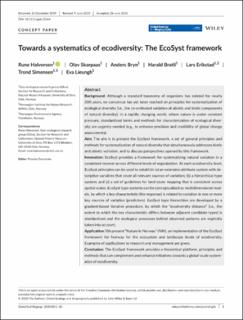Towards a systematics of ecodiversity: The EcoSyst framework
Halvorsen, Rune; Skarpaas, Olav; Bryn, Anders; Bratli, Harald; Erikstad, Lars; Simensen, Trond; Lieungh, Eva
Journal article
Published version

Åpne
Permanent lenke
https://hdl.handle.net/11250/2671046Utgivelsesdato
2020Metadata
Vis full innførselSamlinger
- Scientific publications [1392]
Originalversjon
10.1111/geb.13164Sammendrag
Background Although a standard taxonomy of organisms has existed for nearly 300 years, no consensus has yet been reached on principles for systematization of ecological diversity (i.e., the co‐ordinated variation of abiotic and biotic components of natural diversity). In a rapidly changing world, where nature is under constant pressure, standardized terms and methods for characterization of ecological diversity are urgently needed (e.g., to enhance precision and credibility of global change assessments). Aim The aim is to present the EcoSyst framework, a set of general principles and methods for systematization of natural diversity that simultaneously addresses biotic and abiotic variation, and to discuss perspectives opened by this framework. Innovation EcoSyst provides a framework for systematizing natural variation in a consistent manner across different levels of organization. At each ecodiversity level, EcoSyst principles can be used to establish: (a) an extensive attribute system with descriptive variables that cover all relevant sources of variation; (b) a hierarchical‐type system; and (c) a set of guidelines for land‐cover mapping that is consistent across spatial scales. EcoSyst type systems can be conceptualized as multidimensional models, by which a key characteristic (the response) is related to variation in one or more key sources of variation (predictors). EcoSyst type hierarchies are developed by a gradient‐based iterative procedure, by which the “ecodiversity distance” (i.e., the extent to which the key characteristic differs between adjacent candidate types) is standardized and the ecological processes behind observed patterns are explicitly taken into account. Application We present “Nature in Norway” (NiN), an implementation of the EcoSyst framework for Norway for the ecosystem and landscape levels of ecodiversity. Examples of applications to research and management are given. Conclusion The EcoSyst framework provides a theoretical platform, principles and methods that can complement and enhance initiatives towards a global‐scale systematics of ecodiversity
